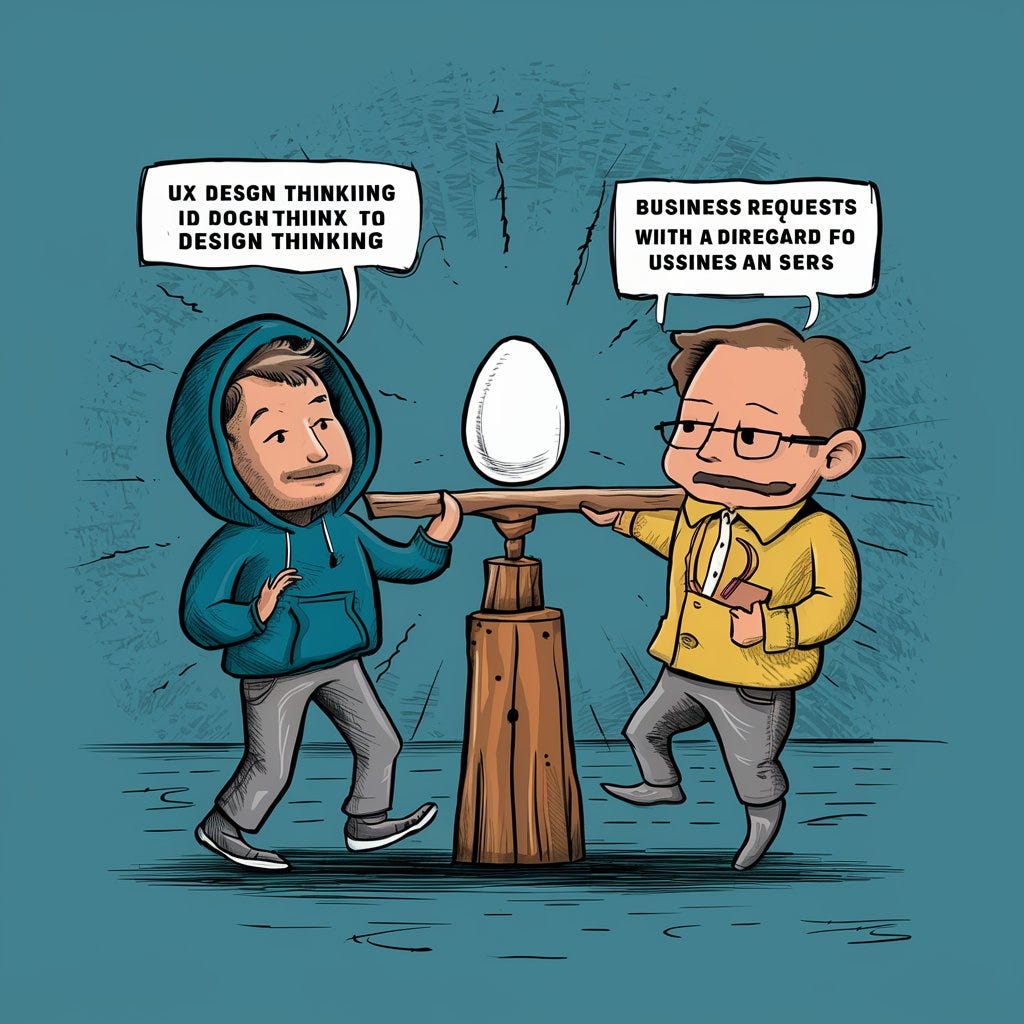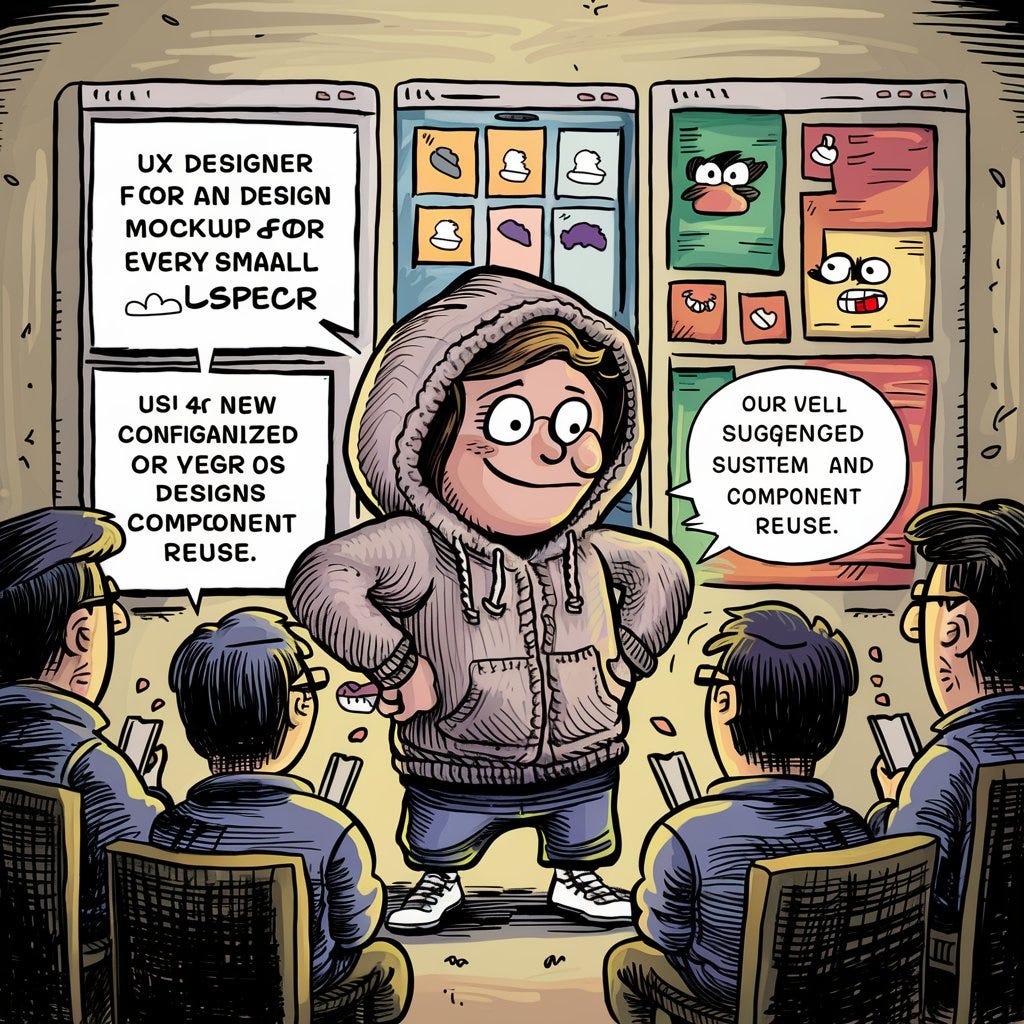
As a product designer, I’ve encountered countless situations where reconciling stakeholder viewpoints with my design judgment and principles feels like walking a tightrope. It’s a predicament many of us face — the quest to deliver exceptional user experiences while fostering productive collaboration.
A common mantra echoes: “Adaptability is key.” And indeed, being able to adjust our approach to meet the needs/lack of design knowledge of stakeholders is a critical skill in the designer’s toolbox. Yet, where do we draw the line between accommodating others and upholding core design tenets?
I’ve outlined several situations below that exemplify the struggle
Level-Setting Expectations with Strong-Personality, Non-Technical Partners

Picture this: You’re in a meeting where enthusiastic but non-tech-savvy business partners dominate the conversation, passionately proposing ideas disconnected from user needs and potential constraints. How might you steer the discussion toward more productive ends?
Reframe the conversation to focus not on prescribed solutions, but on goals and objectives. Calmly underscore the value of leaving solution-crafting to the design team’s expertise. If met with resistance, strategically involve the product manager to reinforce a culture of collaborative trust.
Pushing Back on Unreasonable Requests

As one of the senior designers on the team, part of your role is safeguarding efficient resource allocation. Yet, requests sometimes pour in from other teams that strain the limits of practicality.
Scenario: A colleague bombards you with a laundry list of impractical, misaligned feature ideas. A deft response? Diplomatically explain why some requests aren’t the best use of design bandwidth, citing the need to prioritize initiatives with meaningful user impact. A diplomatic phrase that I use and which I’ve found to be helpful is “That is not a good use of design resources to focus our efforts there, rather ______”. As a seasoned product designer, your perspective lends weight to these conversations, guiding stakeholders towards more strategic decision-making.
Managing Design-Dev Handoff Expectations

While partnering with developers, there are times when their well-intentioned requests risk creating inefficiency. Say developers request exhaustive designs for every minor UI element: every modal, every dropdown, etc — a potential roadblock to streamlined development causing unnecessary bloat in design files.
The right move: Advocate for reusing existing design system components and patterns. Create design system walkthroughs for the dev team and surface how and where each component and its variants are built out. This approach doesn’t just optimize workflows; it reinforces consistency and adherence to standards.
Pushing Past Organizational Inertia

In corporations, processes often calcify over time — once progressive, now obsolete. It’s crucial to recognize when it’s time to evolve.
Perhaps you inherit antiquated design workflows misaligned with modern best practices. How would you deal with the situation? Methodically document the shortcomings, craft a case for change, and secure buy-in from key allies. Key allies would be people who you’ve identified to be influential in the org to promote change. With persistence and diplomacy, you steer organizational transformation towards more effective human-centered processes.
At the heart of masterfully navigating these scenarios lies a fundamental truth — cultivating a reputation as a trusted partner aligned with business imperatives. you need to solidify your standing not merely as a maker of aesthetic choices, but as a strategic facilitator who skillfully harmonizes user experiences with organizational objectives. This hard-earned credibility is the bedrock empowering your deft guidance, enabling you to courteously challenge misguided viewpoints and thoughtfully steer stakeholders toward more user-centric philosophies. Ultimately, you can bridge the divide between design best practices and pragmatic business needs that underpin your ability to drive meaningful, lasting change.
The crux? walking the line between adaptability and principled conviction. Your role transcends crafting visually appealing interfaces — it’s about championing user-centric thinking, fostering healthy collaboration, and realigning misguided efforts.
So the next time you face the need to adapt or educate, remember: You’re not just a designer; you’re a catalyst shaping how your organization approaches design challenges. With poise and expertise, you can deftly navigate stormy stakeholder waters while staying true to your core purpose — crafting exceptional experiences.
When to Adapt, When to Hold Firm: A Product Designer’s Balancing Act was originally published in UX Planet on Medium, where people are continuing the conversation by highlighting and responding to this story.